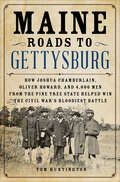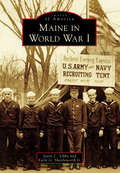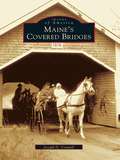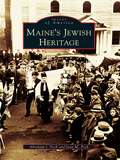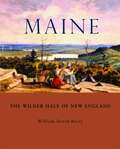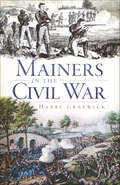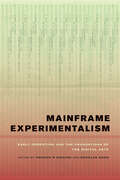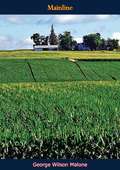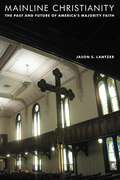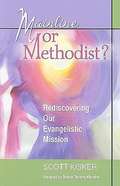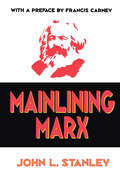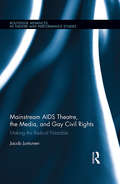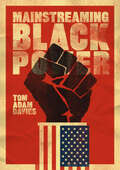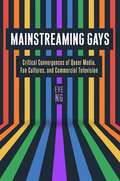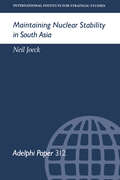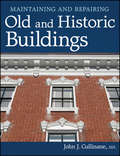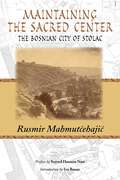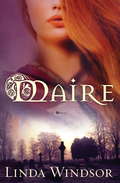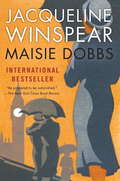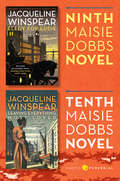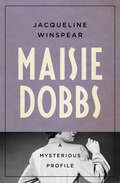- Table View
- List View
Maine Roads to Gettysburg: How Joshua Chamberlain, Oliver Howard, and 4,000 Men from the Pine Tree State Helped Win the Civil War's Bloodiest Battle
by Tom HuntingtonFrom the author of Searching for George Gordon Meade, a study of how troops from Maine aided the Union Army&’s victory at the Battle of Gettysburg. Joshua Lawrence Chamberlain and his 20th Maine regiment made a legendary stand on Little Round Top during the Battle of Gettysburg in July 1863. But Maine&’s role in the battle includes much more than that. Soldiers from the Pine Tree State contributed mightily during the three days of fighting. Pious general Oliver Otis Howard secured the high ground of Cemetery Ridge for the Union on the first day. Adelbert Ames—the stern taskmaster who had transformed the 20th Maine into a fighting regiment—commanded a brigade and then a division at Gettysburg. The 17th Maine fought ably in the confused and bloody action in the Wheatfield; a sea captain turned artilleryman named Freeman McGilvery cobbled together a defensive line that proved decisive on July 2; and the 19th Maine helped stop Pickett&’s Charge during the battle&’s climax. Maine soldiers had fought and died for two bloody years even before they reached Gettysburg. They had fallen on battlefields in Virginia and Maryland. They had died in front of Richmond, in the Shenandoah Valley, on the bloody fields of Antietam, in the Slaughter Pen at Fredericksburg, and in the tangled Wilderness around Chancellorsville. And the survivors kept fighting, even as they followed Robert E. Lee&’s Army of Northern Virginia into Pennsylvania. In Maine Roads to Gettysburg, author Tom Huntington tells their stories. Praise for Searching for George Gordon Meade &“An engrossing narrative that the reader can scarcely put down.&” —Pulitzer Prize-winning historian James M. McPherson &“Unique and irresistible.&” —Lincoln Prize-winning historian Harold Holzer
Maine in World War I (Images of America)
by Earle G. Shettleworth Jr. Jason C. LibbyWith the same patriotic fervor as Maine�s response to a call for troops in the Civil War, more than 35,000 men and women across the state joined the armed forces in 1917�1918 to fight in aid of America�s European allies against Germany, as well as to redress German destruction of American vessels in the North Atlantic. Mainers also provided vital support to the United States and the Allies through war-related industries, like shipbuilding, munitions, textiles, and agriculture, while purchasing more than $100 million in war bonds and donating bandages, books, and other comforts of home to the troops. The war may have been �over there,� but its effects were found throughout the state of Maine.
Maine to Cape Horn: The World's Most Dangerous Voyage (Transportation)
by Charles H. LagerbomCape Horn conjures up images of wind-whipped waters and desperate mariners in frozen rigging. Long recognized as a maritime touchstone for sailors, it marks the spot where the Pacific and Atlantic Oceans meet in one writhing mass. "Doubling" Cape Horn became the ultimate test, earning a prominent place in Maine maritime history. At the end of South America, it shares longitude 67° west exactly with Cutler, Maine, a direct north-south line of seven thousand miles. Maine Cape Horners were recognized by a golden earring. If they did not survive this most difficult journey in the world, the earring covered the costs of their funeral, should the body ever be found. Maritime historian Charles H. Lagerbom traveled to the end of the world to help research this exciting story of bold Mainers and their exhilarating and oftentimes deadly dance with danger.
Maine's Covered Bridges (Images of America)
by Joseph D. ConwillMaine once had more than one hundred covered bridges. Only seven of these bridges remain today, but the photographic record of the others is surprisingly complete. Maine's Covered Bridges offers views of these structures that once graced the state's roads and railroads, many of them in the Oxford Hills and Western Mountains regions. All of Maine's major rivers-the Saco, Androscoggin, Kennebec, Penobscot, and Aroostook-and even smaller rivers-including the Presumpscot, Ossipee, Little Androscoggin, Ellis, Sandy, Piscataquis, Narraguagus, and St. Croix-had a covered bridge.
Maine's Jewish Heritage (Images of America)
by Abraham J. Peck Jean M. PeckAccording to historian Benjamin Band, the first record of a Jew in Maine concerns Susman Abrams, a tanner who resided in Union until his death at 87 in 1830. Historical records beginning in 1849 also tell of a small Bangor community that organized a synagogue and purchased a burial ground. But it was not until the late 19th century that Jewish communities grew large enough to establish multiple synagogues, Hebrew schools for boys, kosher butcher shops, and Jewish bakeries. Eventually there were Jewish charitable societies, community centers, and social clubs across the state. Now, 150 years later, Jews serve every Maine community in every possible capacity, free from the barriers of social or religious discrimination. This book honors the accomplishments of Maine's Jewish residents.
Maine: The Wilder Half Of New England (G - Reference,information And Interdisciplinary Subjects Ser.)
by William David BarryIllustrated with well over 200 images drawn from the collections of the Maine Historical Society, the Maine Historic Preservation Commission, Special Collections at the Portland Public Library, the Maine State Museum, local historical societies, private collections, and even the Vatican, these pages contain many rare and fascinating drawings, paintings, and photographs. The bibliography is a rich resource for exploring Maine history further.
Mainers in the Civil War (Civil War Series)
by Harry GratwickToo far north, the great state of Maine did not witness any Civil War battles. However, Mainers contributed to the war in many important ways. From the mainland to the islands, soldiers bravely fought to preserve the United States in all major battles. Men like General Joshua Chamberlain, a hero of Little Round Top, proudly returned home to serve as governor. Maine native Hannibal Hamlin served as Abraham Lincoln's first vice president. And Maine's strong women sacrificed and struggled to maintain their communities and support the men who had left to fight. Author Harry Gratwick diligently documents the stories of these Mainers, who preserved "The Way Life Should Be" for Maine and the entire United States.
Mainframe Experimentalism: Early Computing and the Foundations of the Digital Arts
by Douglas Kahn Hannah B. HigginsMainframe Experimentalism challenges the conventional wisdom that the digital arts arose out of Silicon Valley’s technological revolutions in the 1970s. In fact, in the 1960s, a diverse array of artists, musicians, poets, writers, and filmmakers around the world were engaging with mainframe and mini-computers to create innovative new artworks that contradict the stereotypes of "computer art." Juxtaposing the original works alongside scholarly contributions by well-established and emerging scholars from several disciplines, Mainframe Experimentalism demonstrates that the radical and experimental aesthetics and political and cultural engagements of early digital art stand as precursors for the mobility among technological platforms, artistic forms, and social sites that has become commonplace today.
Mainline
by George Wilson MaloneWherever he went, in whatever country he visited, Senator Malone applied himself to the purpose of his visit with the mind of a trained engineer. Two things were uppermost in his thoughts. They were these:—What was the relationship between facts and events as he saw them, and the strategic position of these United States; and—What was the cumulative effect of other countries’ policies upon the workingmen and investors of his own Nation, whether in industry or on ranch or farm?He reported his findings to his colleagues in the Senate, in floor debates; the committees on which he served published literally thousands of pages of his reports. The people of Nevada re-elected him to the Senate in 1952.For the next two years Senator Malone was chairman of the Minerals, Materials and Fuels Economics Subcommittee of the Senate Committee on Interior and Insular Affairs. He went on to rank as minority member of the latter Committee and a member of the Senate Committee on Finance.This is the man whose reports and analyses you are about to read, and whose specific proposals are presented for your assessment.
Mainline Christianity: The Past and Future of America's Majority Faith
by Jason S LantzerSince the Revolutionary War, Mainline Christianity has been comprised of the Seven Sisters of American Protestantism—the Congregational Church, the Episcopal Church, the Evangelical Lutheran Church, the Presbyterian Church, the United Methodist Church, the American Baptist Convention, and the Disciples of Christ.These denominations have been the dominant cultural representatives since the nineteenth century of how and where the majority of American Christians worship. Today, however, the Seven Sisters no longer represent most American Christians. The Mainline has been shrinking while evangelical and fundamentalist churches, as well as non denominational congregations and mega churches, have been attracting more and more members.In this comprehensive and accessible book, Jason S. Lantzer chronicles the rise and fall of the Seven Sisters, documenting the ways in which they stopped shaping American culture and began to be shaped by it. After reviewing and critiquing the standard decline narrative of the Mainline he argues for a reconceptualization of the Mainline for the twenty-first century, a new grouping of Seven Sisters that seeks to recognize the vibrancy of American Christianity.
Mainline or Methodist?: Rediscovering Our Evangelistic Mission
by Scott KiskerWhere do we go from here? The dynamic history and identity of the United Methodist Church is lost among the pluralistic landscape in America today. As a living organism, the church can expect to evolve alongside and within resident culture. The problem, according to lifelong member and author Kisker, is the United Methodist Church seems to have lost its missional foundation as it climbed to mainline American Protestant church status. Trying to be both mainline and Methodist is a deadly combination. In fact, it's a leading cause for the denomination's spiritual and numerical decline. ""Real Methodism declined because we replaced those peculiarities that made us Methodist with a bland, acceptable, almost civil religion, barely distinguishable from other traditions,"" writes Kisker. ""Like the Israelites under the judges, we wanted to be like other nations. We no longer wanted to be an odd, somewhat disreputable people. And we have begun to reap the consequences."" So...where do go from here? In his passionate yet critical review, Kisker says we must reclaim the rich roots of salvation, disciple-making and witness that made the tradition so strong. In Mainline or Methodist? he reveals what's not working and unveils a vision to renewal that embodies the distinctive Wesleyan tradition of the apostolic and universal Christian faith.
Mainlining Marx
by John L. StanleyIn recent years a host of Western Marxists have tried to emancipate Marx from responsibility for various unsavory doctrines. Political theorists have argued that Marx can avoid the weight of Stalinism and also the various theories, such as positivism, naturalism, Darwinism, technological determinism and the dialectics of nature that support Marxism. In the course of building up their defense of Marx, these modern critics have developed an elaborate but often confusing rationale whose premise consists of attributing many of the nefarious tendencies of Marxism to Engels, particularly the latter's philosophy of nature. In Mainlining Marx, John L. Stanley sets Marx's view of nature back in its proper perspective.Stanley challenges the "new orthodoxy" of prominent Marxist scholars who see a fundamental dichotomy between Marx and Engels with the latter believing in cosmic superlaws and the former adhering to historically grounded ones. Stanley argues both Marx and Engels used historical and transhistorical laws at various times. He is highly critical of those who abstract theoretical principles out of texts Marx wrote with specific and historical political goals in mind. He takes issue, as well, with critics who posit a Marxian belief in communist as against natural needs, and further challenges the new orthodoxy in his analysis of Marx's dissertation, showing that from the beginning Marx's thought was grounded in materialist determinism.Supplementing the chapters on Marx and his critics, the volume concludes with an essay on Georges Sorel's approach to textual analysis and interpretation, showing how Sorel, far in advance of his time realized the impossibility of completely objective analysis and the inevitable distortion of the subject under study.Throughout this volume, Stanley's critical approach utilizes Sorel's illuminating insights to point out the distortions in modern Marxian analysis. Challenging and original, Mainlining Marx is a major contribution to the study of Marxism. It will be read by economists, political scientists, and intellectual historians.
Mainstream AIDS Theatre, the Media, and Gay Civil Rights: Making the Radical Palatable (Routledge Advances in Theatre & Performance Studies)
by Jacob JuntunenThis book demonstrates the political potential of mainstream theatre in the US at the end of the twentieth century, tracing ideological change over time in the reception of US mainstream plays taking HIV/AIDS as their topic from 1985 to 2000. This is the first study to combine the topics of the politics of performance, LGBT theatre, and mainstream theatre’s political potential, a juxtaposition that shows how radical ideas become mainstream, that is, how the dominant ideology changes. Using materialist semiotics and extensive archival research, Juntunen delineates the cultural history of four pivotal productions from that period—Larry Kramer’s The Normal Heart (1985), Tony Kushner’s Angels in America (1992), Jonathan Larson’s Rent (1996), and Moises Kaufman’s The Laramie Project (2000). Examining the connection between AIDS, mainstream theatre, and the media reveals key systems at work in ideological change over time during a deadly epidemic whose effects changed the nation forever. Employing media theory alongside nationalism studies and utilizing dozens of reviews for each case study, the volume demonstrates that reviews are valuable evidence of how a production was hailed by society’s ideological gatekeepers. Mixing this new use of reviews alongside textual analysis and material study—such as the theaters’ locations, architectures, merchandise, program notes, and advertising—creates an uncommonly rich description of these productions and their ideological effects. This book will be of interest to scholars and students of theatre, politics, media studies, queer theory, and US history, and to those with an interest in gay civil rights, one of the most successful social movements of the late twentieth century.
Mainstream – freie Meinung – Populismus: Interdisziplinäre Beiträge zur Debattenkultur und zu Spaltungstendenzen der Gesellschaft
by Lothar HäberleDer Mainstream, prinzipiell wandelbar, ist seit einigen Jahren geprägt von erheblicher Enge (d.h. Diskurs-Ächtung einiger Teile der Gesellschaft). Meinungsfreiheit implodiert, besonders durch Ausgrenzungen Privater. Zudem radikalisieren sich kleinere Gruppen, wozu das Internet viel beiträgt. Im Populismus – von rechts wie von links – haben gesellschaftliche Spaltungstendenzen dann schon deutliche Prägung erfahren. Die Frage, wann und ob das Phänomen einer im engeren Sinne „gespaltenen Gesellschaft“ vorliegt, wird hier kaum direkt behandelt, die acht Buchbeiträge jedoch stehen in vielfältiger Beziehung hierzu. Gesellschaftlichen Spaltungstendenzen kann entgegnet werden: u.a. durch Beachtung einiger Diskurs-Grundsätze, auch im Online-Bereich.
Mainstreaming Black Power
by Tom Adam DaviesMainstreaming Black Power upends the narrative that the Black Power movement allowed for a catharsis of black rage but achieved little institutional transformation or black uplift. Retelling the story of the 1960s and 1970s across the United States—and focusing on New York, Atlanta, and Los Angeles—this book reveals how the War on Poverty cultivated black self-determination politics and demonstrates that federal, state, and local policies during this period bolstered economic, social, and educational institutions for black control. Mainstreaming Black Power shows more convincingly than ever before that white power structures did engage with Black Power in specific ways that tended ultimately to reinforce rather than challenge existing racial, class, and gender hierarchies. This book emphasizes that Black Power’s reach and legacies can be understood only in the context of an ideologically diverse black community.
Mainstreaming Gays: Critical Convergences of Queer Media, Fan Cultures, and Commercial Television
by Eve NgMainstreaming Gays discusses a key transitional period linking the eras of legacy and streaming, analyzing how queer production and interaction that had earlier occurred outside the mainstream was transformed by multiple converging trends: the emergence of digital media, the rising influence of fan cultures, and increasing interest in LGBTQ content within commercial media. The U.S. networks Bravo and Logo broke new ground in the early 2000s and 2010s with their channel programming, as well as bringing in a new cohort of LGBTQ digital content creators, providing unprecedented opportunities for independent queer producers, and hosting distinctive spaces for queer interaction online centered on pop culture and politics rather than dating. These developments constituted the ground from which recent developments for LGBTQ content and queer sociality online have emerged. Mainstreaming Gays is critical reading for those interested in media production, fandom, subcultures, and LGBTQ digital media.
Maintaining Arctic Cooperation with Russia: Planning for Regional Change in the Far North
by Stephanie Pezard Abbie Tingstad Kristin Van Abel Scott StephensonThis report examines potential transformations that could alter Russia’s current cooperative stance in the Arctic. It analyzes current security challenges related to climate and geography, economy, territorial claims, and military power, suggests some ways in which these could undermine Arctic cooperation, and offers recommendations for the U.S. government to manage the risks to cooperation.
Maintaining Nuclear Stability in South Asia (Adelphi series)
by Neil JoeckArgues that, while nuclear weapons and ballistic missiles cast a shadow over Indo-Pakistani relations, they do not create strategic stability. He asserts that the development of command and control mechanisms would enhance stability, but that diplomatic steps focused on missiles must also be considered. Improved command and control and diplomatic engagement will provide some insurance that nuclear weapons are not used in any future conflict.
Maintaining and Repairing Old and Historic Buildings
by John J. CullinaneA practical guide to the maintenance and repair of old and historic buildings Carrying out work in accordance with the U. S. Secretary of the Interior's standards and guidelines can be a challenge for professionals charged with the preservation, restoration, and care of historic properties. This book-with-CD package facilitates the process with more than 400 field guidelines for the treatment of historic building structures, systems, and materials. It includes: Background and rationale for treatment Annotated standards and guidelines Step-by-step treatment instructions Information on energy conservation and meeting LEED and ADA requirements The treatment guidelines cover a wide range of issues, from how to replace broken glass in wood and metal windows to preparing historic mortar. Each guideline can be printed out individually from the accompanying CD for easy reference and on-site use. Well organized and easy to use, Maintaining and Repairing Old and Historic Buildings is a valuable resource for architects, engineers, facility managers, and related professionals working in the areas of building preservation and restoration.
Maintaining the Sacred Center: The Bosnian City of Stolac
by Rusmir MahmutcehajicIn his fascinating new book, Bosnian academic and former statesman, Rusmir Mahmutcehajic, explores how men and women traditionally ordered their communities, architecture, and habits of life to reflect the divine order, and how this order is coming under attack in an increasingly secularized modern world. In reflecting on how his own hometown of Stolac, Bosnia, has been destroyed and then rebuilt in the aftermath of the tragic Bosnia war, he offers explanations as to how different religious communities can live peacefully together in the future.
Maire (The Fires of Gleannmara #1)
by Linda WindsorA fanciful, romantic tale of passion and faith that invites readers to the "God-graced mountains and plains" of Ireland. Maire, Gleannmara's warrior queen, finds her fierce heart is gentled when she takes a reformed mercenary -- a Christian, no less -- as hostage during a raid. At first she wonders what kind of God would make a fine warrior like Rowan of Emerys such a coward. But as she comes to know Rowan and witnesses the force of his beliefs, she learns that meekness and humility to the one true God are stronger than any blade of steel. And in the process, Maire discovers the transforming power of love and faith.From the Trade Paperback edition.
Maisie Dobbs (Maisie Dobbs #1)
by Jacqueline WinspearMaisie entered domestic service in 1910 at the age of thirteen, to work as a maid at the Belgravia mansion of Lady Rowan Compton. When her remarkable intelligence and innate love of learning are discovered by her employer, Maisie becomes the pupil of Maurice Blanche, a learned friend of the Comptons who is often retained by Europe's elite, and the police, to conduct discreet investigations. Eventually, Maisie enters Girton College at Cambridge University, but the escalation of World War I intervenes to change her plans. She serves as a nurse at the front and falls in love with a handsome young doctor, only to lose him. In 1929, following an apprenticeship assisting Blanche iin his work, Maissie hangs out her shingle: M. DOBBS, TRADE AND PERSONAL INVESTIGATIONS. She soon becomes enmeshed in a mystery suurrounding The Retreat, a reclusive community of veterans wounded in body and spirit. At first, Maisie only suspects foul play, but she must act quickly when Lady Rowan's son decides to sign away his fortune and take refuge at The Retreat. A coincidence? Maisie has learned that coincidences can lead to the truth, and hurriedly investigates The Retreat. She uncovers a disturbing mystery at its core which in an astonishing dénouement, gives Maisie the courage to confront the ghost that has haunted her for over ten years.
Maisie Dobbs Bundle #4: Elegy for Eddie and Leaving Everything Most Loved
by Jacqueline WinspearThis eBook bundle includes books 9 & 10 in Jacqueline Winspear's New York Times bestselling Maisie Dobbs series: Elegy for Eddie and Leaving Everything Most Loved.
Maisie Dobbs: A Mysterious Profile (Mysterious Profiles #3)
by Jacqueline WinspearFour fictional characters are interviewed in this profile of the adventurous sleuth, by the New York Times–bestselling author of A Sunlit Weapon. The historical mystery Maisie Dobbs was first published in 2003, introducing readers to an inquisitive, young, English, working-class woman as she opens her own London detective agency following World War I. Jacqueline Winspear&’s debut won her the Agatha Award for Best First Novel and led to a New York Times–bestselling series. But just who exactly is Miss Maisie Dobbs? In this profile, four characters very close to Maisie shed light on the beloved psychologist and investigator. Her father, Francis Dobbs looks back on her childhood and proclaims the pride she instills in him. Her first employer, Lady Rowan Compton, recounts finding a young Maisie studying late one night in her library. Dr. Maurice Blanche, her mentor, discusses her studies and their detective work. And Billy Beale, her assistant, talks about their first meeting during the Great War, as well as what it&’s like to work for her. It&’s an enlightening read that fans are sure to love. Praise for Jacqueline Winspear and the Maisie Dobbs Novels &“A detective series to savor.&” —Time &“In Maisie Dobbs, Jacqueline Winspear has given us a real gift. Maisie Dobbs has not been created—she has been discovered. Such people are always there amongst us, waiting for somebody like Ms. Winspear to come along and reveal them. And what a revelation it is!&” —Alexander McCall Smith &“History comes alive when a character you think of as a friend is in the thick of the action. That&’s how Jacqueline Winspear keeps her Maisie Dobbs series so fresh.&” —The New York Times Book Review &“Maisie&’s liveliness of mind, good sense, and kind nature make her a heroine a reader can enjoy spending time with.&” —The Boston Globe &“The author gives an intelligent and absorbing picture of the period, providing plentiful details for the history buff without detracting from the riveting mystery. Readers will be eager to see more of the spunky Maisie.&” —Publishers Weekly, starred review
Maitland y San Martín
by Rodolfo TerragnoSan Martín, dice el autor, «era un estratega y, como tal, un estudioso;no un aventurero». Nadie sabía de su existencia. Durante 184 años el Plan Maitlandpermaneció oculto en archivos británicos. Cuando Rodolfo Terragno lodescubrió, se produjo un giro en la historia de San Martín. Ningúnhallazgo la había modificado antes de tal manera.El plan, presentado por Sir Thomas Maitland en 1800 al primer ministrobritánico William Pitt, preveía tomar Buenos Aires y luego, desdeMendoza, cruzar los Andes para «liberar» a Chile y seguir en barco parahacer lo mismo con Perú. Faltaban aún diecisiete años para que SanMartín iniciara su campaña libertadora.La existencia de este plan desmiente los supuestos de historiadoresclásicos. Mitre, por ejemplo, sostenía que «así como la vida de Colónestá encerrada en su idea de ir al oriente por occidente, la de SanMartín está encerrada en la de llevar la libertad a través de lacordillera y el Pacífico, hasta Lima». José Pacífico Otero decía que anadie más podría habérsele ocurrido. Terragno afirma, en cambio, queSan Martín no emprendió su gesta confiando solo en su intuición, sinoque había accedido en Inglaterra a preciosos documentos sobre Sudaméricay los modos de ocuparla. Este libro demuestra que el Libertador preparócuidadosamente su campaña en Londres.
